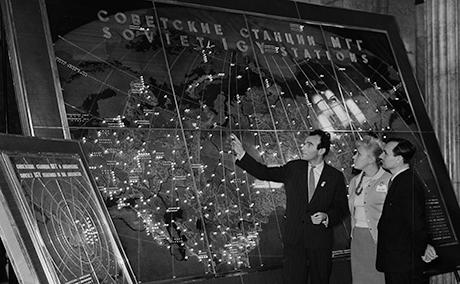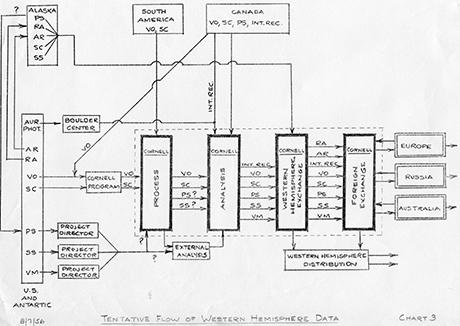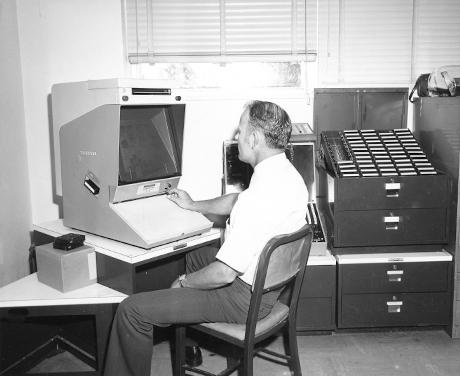The history of the International Geophysical Year or IGY (1957–1958) and its system of World Data Centers illustrates the ways in which data practices both shaped and were shaped by the political economy of the Cold War, beyond the militarization of research as a more direct consequence of the conflict. One of the twentieth century’s largest scientific international ventures, the IGY involved 67 countries and thousands of scientists in its ambitious program of data collection. At the height of the Cold War, the IGY enabled an unprecedented global circulation of data on various aspects of the physical environment. All thirteen IGY disciplines—aurora and airglow, cosmic rays, geomagnetism, glaciology, gravity, ionospheric physics, longitudes and latitudes, meteorology, nuclear radiation, oceanography, seismology, solar activity, and upper atmosphere studies using rockets and satellites—had direct military implications. Yet the data were open for free exchange, even between the key Cold War adversaries, the United States and the USSR. What made such sharing possible? What was the value of the data for the IGY planners? And why, given their critical significance, were most of the IGY data not used at the time, with many still “buried” in the archives even today? These are some of the project’s driving questions.
The study is motivated by the idea of the co-production of the political and scientific-technological orders. Based on existing studies of science in the Cold War and on archive-based research, it examines scientific practices during the Cold War era through the “data axis.” The IGY, which was conceived against a background of nuclear secrecy intensified by Cold War political tensions, enabled the emergence of a distinct data regime in geophysics—a regime that turned data into a form of currency, traded and exchanged by the political players of the Cold War. To examine this data regime, the project pursues four thematic strands:
(1) Cold War secrecy and data access.
In the aftermath of World War II, two imperatives—the strategic importance of geophysical data with the advent of nuclear weapons, and the nuclear secrecy regime established in geophysics as a result—coalesced to make geophysical data a site of both political struggle and international cooperation. Whereas the military used the IGY to obtain access to critical geophysical data, scientists used it to renegotiate the boundary between open and classified data. The IGY planners adopted a particular strategy in their negotiations of “what can be shared with the enemy,” promoting the distinction between “basic data”—the elementary units of information that had no value without context and could therefore be exchanged with an enemy—and “final products,” such as reports that could be classified. The distinction embedded a thin, “atomistic” epistemology, but it allowed scientists to make a case for international data-sharing agreements in geophysics. What counted as “open data” to be exchanged during the program was formalized in the IGY’s Guides to Data Exchange. However, the actual exchange was governed by more subtle politics that did not translate into a formal set of rules and regulations. In the practices of IGY data exchange, the value of data was determined by the Cold War political economy rather than by formal international agreements.

Figure 2: Map of Soviet IGY stations, displayed at the conference on the results of the IGY (Moscow, 1963). Courtesy of the Russian State Archive of Documentary Films and Photographs, Moscow.
(2) The Cold War political economy of data exchange.
The implicit assumption in the IGY Guides was that, once “opened,” data would automatically “flow” to the World Data Centers (WDCs). The geophysicists often referred to “torrents of data” “flowing” in and out of the data centers. In actuality, the IGY data did not flow effortlessly and smoothly like a fluid. Making data flow rather than trickle (or, indeed, come to a halt) required constant negotiation and oversight. The asymmetry of exchange was the pump that made data “flow.” The geophysicists in charge of the Soviet WDC never missed an opportunity to point this out to their patrons, arguing that the data received by the center were reciprocated asymmetrically to the advantage of the Soviet Union. On both sides of the political divide, the WDCs kept track of the “data flow,” counting and monitoring the number of the “pieces of data” received in their centers and exchanged with the others. With these practices, data came to be seen as an exchange currency in the possession of the two main “keepers” of planetary geophysical information, the United States and the USSR. This politicization of data exchange would have unanticipated consequences for the data centers and their data practices.

Figure 3: The chart of data flow through the system of World Data Centers during the IGY. Courtesy of the Archives of National Academy of Sciences, Washington, D.C.
(3) Data accumulation: the analog data deluge.

Figure 4: The microfilm vault at the IGY Data Center for Airglow and Ionosphere, Boulder Laboratories, National Bureau of Standards (Boulder, CO, 1958). Courtesy of the Archives of the National Academy of Sciences, Washington, D.C.
Data having become a currency, the WDCs’ main purpose was to accumulate large volumes of data, mostly recorded in an analog format. By the end of the 1960s, their holdings still growing, the WDCs made up a massive distributed “archive of numerical data, curves, maps, and pictures,” as the executive director of the American WDC put it. In the 1960s, the WDCs constituted the largest repository of environmental data ever seen in geophysics. With the growing concern for environmental issues, the IGY data centers started to be seen as a treasure chest of data with the potential to answer questions beyond the immediate concerns of geophysics. But the keys to that treasure chest turned out to be missing—extracting useful information from the masses of accumulated data was an extremely daunting task. Because of the massive volume of data and its diversity, computers were latecomers to the world of the WDCs. After the IGY, both American and Soviet geophysicists faced the technological challenge of handling the accumulated data and putting them to use. Their technological solutions, however, differed on the two sides of the “iron curtain.”
(4) Cold War technologies of data archives.
While American geophysicists chiefly explored ways of converting the analog data into a machine-readable format, their Soviet counterparts were equally interested in the possibilities of data processing and information retrieval using microfilming technologies. In the 1960s, microfilming was a sophisticated technology that allowed users to store, search, and analyze analog data without turning them into a digital format. Unlike computers, with their close links to the military, microfilm-based technologies were relatively accessible. They were produced by many countries—including the Soviet satellite East Germany, which provided Soviet entrepreneurial engineers and inventors with a variety of models to emulate and adapt—and offered a promising alternative to computers for the purposes of handling geophysical data.

Figure 5: Recordak Lodestar microfilm reader printer, circa 1960. Courtesy of the Mississippi Department of Archives and History.
The analysis carried out by this study is a reminder that data are not simply transparent evidence about events in the world, but are contingent on relations of power. During the IGY, data exchange became a mechanism of soft power exercised by the IGY planners, reproducing geopolitical rivalries in the smaller theater of the Cold War’s data battles. As much as anything else, the project draws attention to unanticipated outcomes of the Cold War political data economy (which are often over-rationalized in hindsight). The strategic significance of geophysical data did not translate directly and deterministically into making “data-products.” In the 1960s, the WDCs became a relic of the era of analog data with its microfilm technologies. The study thus sheds light on the complex intertwining of the political with the technological in the history of data practices that gave “big data” its momentum during the Cold War.
